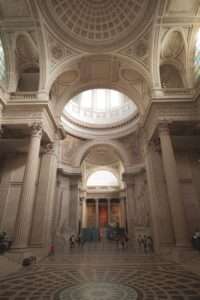|To Its Great Men The Grateful Homeland|
The Pantheon sits atop Mont Sainte Geneviève, in the Latin Quarter, and is one of the more noticeable landmarks of Paris. It stands next to the church of Saint Etienne du Mont. An inscription above the entrance reads “Aux Grands Hommes La Patrie Reconnaisante” (To Its Great Men The Grateful Homeland).

The Pantheon of Paris architecture
It was built to be a church dedicated to St. Genevieve (death in 502), the sainte patronne of Paris, on the same site as the then standing, though falling into ruins, Abbey of St. Genevieve. Its construction was ordered by Louis XV, in 1744. Born on February 15, 1710 in Versailles and died on May 10, 1774 in the same city, is a king of France and Navarre, he succeeded his great-grandfather Louis XIV at the age of five. The construction of the Pantheon began in 1758, directed by architect Jacques Germain Soufflot (1713-1780).
After the French Revolution, the building lost its role as a church and became the mausoleum for the entombment of great Frenchmen. Very Few women are also entombed here: Sophie Berthelet, who was entombed with her husband, Marcellin, in 1907; Marie Curie, entombed in 1995; Simone Veil, entombed in 2018; Joséphine Baker, entombed in 2021.
Indeed, it is built in the style of Neoclassicism, the first in Paris, which breaks from the rococo and baroque, emphasizing simplicity and grandeur. It set the standard for other monuments built in the same style such as the Arc de Triomphe and the church La Madeleine.
The Pantheon in Paris is modeled after the Pantheon in Rome, as well as St. Paul’s cathedral in London, and is in the shape of a Greek Cross. Its façade is like a Greek temple and is distinguished with 18 Corinthian columns. The building itself is 110 meters in length (350 feet), 84 meters wide (270 feet) and 83 meters high (270 feet).
The interior of the dome is decorated with a fresco, “Assumption of St. Genevieve” (1811) by Antoine-Jean Gros. The walls have frescoes depicting the life of Sainte Geneviève, frescoes of Charlemagne, of Louis IX named Saint Louis, both kings of France and Joan of Arc.
Pantheon Paris and the history of France
- In 1744, Louis XV ordered the construction dedicated to St. Genevieve (death in 502), the sainte patronne of Paris
- In 1758, the construction of the Pantheon began in 1758 directed by architect Jacques Germain Soufflot (1713-1780)
- in 1789, After the French Revolution, the building lost its role as a Paris church and became the mausoleum of great Frenchmen
- In 1806, Napoleon I, Emperor of France since 1804, gave the building back to the Church while the crypt stood for the great men.
- In 1830, it was again property of the State to the great men under Louis-Philippe, last king to have reigned in France, between 1830 and 1848
- In 1851, Louis Napoleon, the future Napoleon III, newphew of Napoleon I turned it back into a place of worship. Napoleon III was the first President of France from 1848 to 1852, and the last monarch of France as Emperor of the French from 1852 until 1870
- In 1871, the landmark is occupied by the communards during the civil war which opposed them to the government of Versailles. Most of them are small tradesmen, workers, employees or artists. The profiles of the Communards are largely related to socialism (historical trends of the time), anarchism or other movements claiming self-management.
- In 1885, the building returned to its Republican destination for the last time
Moreover, in 1851, Leon Foucault exhibited his famous Foucault Pendulum in the Observatoire de Paris. Napoleon III asked for another demonstration the same year, to be presented in the Pantheon. Indeed, This demonstration provided the proof, that the earth does spin on its axis.
Pantheon Paris and its great women and men
Chronological non-exhaustive list of some Entombed in the Pantheon
- 1791 Voltaire
- 1794 Jean-Jacques Rousseau
- 1885 Victor Hugo
- 1908 Émile Zola
- 1920 Léon Gambetta (urn with his heart)
- 1924 Jean Jaurès
- 1949 Félix Éboué (1st “colored” person entombed here)
- 1964 Jean Moulin
- 1988 Jean Monnet
- 1989 Abbé Baptiste-Henri Grégoire
- 1995 Pierre Curie
- 1995 Marie Curie (1st woman entombed in the Panthéon for her works)
- 1996 André Malraux
- 2002 Alexandre Dumas
- 2018 Simone Veil
- 2021 Joséphine Baker
Combination of Paris Tour Guide Packages
PARIS BY EMY offers customizable Paris tour guide packages that allow you to combine different types of experiences.
You can also personalize the tours to focus on specific themes or leisure activities, tailoring the experience to your preferences. Discover the Latin Quarter within a private tour.
Emy,

